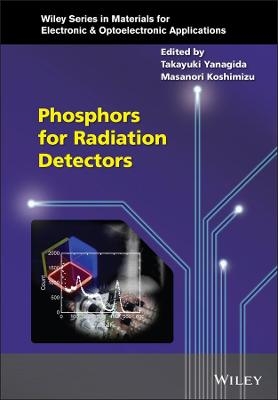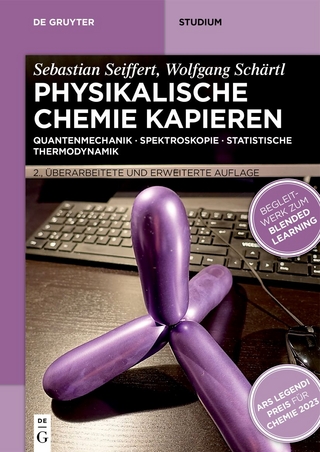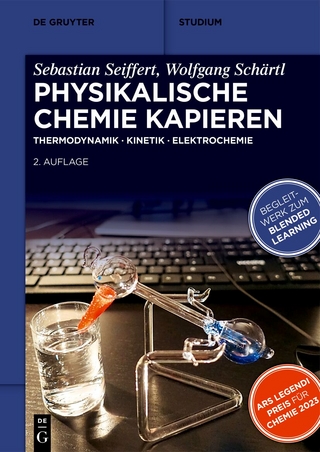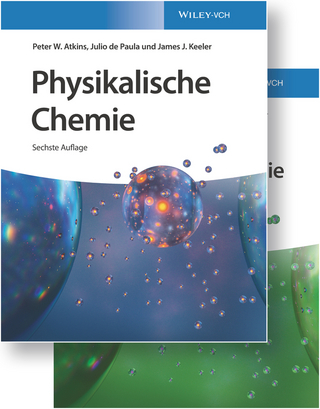
Phosphors for Radiation Detectors
John Wiley & Sons Inc (Verlag)
978-1-119-58332-5 (ISBN)
Discover a comprehensive overview of luminescence phosphors for radiation detection
In Phosphors for Radiation Detection, accomplished researchers Takayuki Yanagida and Masanori Koshimizu deliver a state-of-the-art exploration of the use of phosphors in radiation detection. The internationally recognized contributors discuss the fundamental physics and detector functions associated with the technology with a focus on real-world applications.
The book discusses all forms of luminescence phosphors for radiation detection used in a variety of fields, including medicine, security, resource exploration, environmental monitoring, and high energy physics.
Readers will discover discussions of dosimeter materials, including thermally stimulated luminescent materials, optically stimulated luminescent materials, and radiophotoluminescence materials. The book also covers transparent ceramics and glasses and a broad range of devices used in this area.
Phosphors for Radiation Detection also includes:
Thorough introductions to ionizing radiation induced luminescence, organic scintillators, and inorganic oxide scintillators
Comprehensive explorations of luminescent materials, including discussions of materials synthesis and their use in gamma-ray, neutron, and charged particle detection
Practical discussions of semiconductor scintillators, including treatments of organic-inorganic layered perovskite materials for scintillation detectors
In-depth examinations of thermally stimulated luminescent materials, including discussions of the dosimetric properties for photons, charged particles, and neutrons
Relevant for research physicists, materials scientists, and electrical engineers, Phosphors for Radiation Detection is an also an indispensable resource for postgraduate and senior undergraduate students working in detection physics.
Edited by Takayuki Yanagida, PhD, is Professor at the Graduate School of Materials Science, Nara Institute of Science and Technology in Japan. He obtained his doctorate from the University of Tokyo. His research interests include inorganic crystal, transparent ceramic, and glass phosphors. Masanori Koshimizu is Associate Professor at the Graduate School of Engineering at Tohoku University. He has authored over 160 papers in the fields of Applied Chemistry and Quantum Physical Chemistry Series Editors Arthur Willoughby University of Southampton, Southampton, UK Peter Capper Ex-Leonardo MW Ltd, Southampton, UK Safa Kasap University of Saskatchewan, Saskatoon, Canada
List of Contributors xi
Preface xiii
Series Preface xv
1 Ionizing Radiation Induced Luminescence 1
Takayuki Yanagida
1.1 Introduction 1
1.2 Interactions of Ionizing Radiation with Matter 3
1.3 Scintillation 4
1.3.1 Energy Conversion Mechanism 4
1.3.2 Emission Mechanism 5
1.3.3 Scintillation Light Yield and Energy Resolution 8
1.3.4 Timing Properties 14
1.3.5 Radiation Hardness 17
1.3.6 Temperature Dependence 18
1.4 Ionizing Radiation Induced Storage Luminescence 18
1.4.1 General Description 18
1.4.2 Analytical Description of TSL 19
1.4.3 Analytical Description of OSL 24
1.5 Relationship of Scintillation and Storage Luminescence 26
1.6 Common Characterization Techniques of Ionizing Radiation Induced Luminescence Properties 29
References 35
2 Organic Scintillators 39
Masanori Koshimizu
2.1 Introduction 39
2.2 Basic Electronic Processes in Organic Scintillators 40
2.2.1 Electronic States and Excited States Dynamics of Organic Molecules 40
2.2.2 Excitation Energy Transfer 43
2.2.3 Scintillation Dynamics in Organic Scintillators at High Linear Energy Transfer 50
2.3 Liquid Scintillators 51
2.4 Organic Crystalline Scintillators 54
2.5 Plastic Scintillators 55
2.6 Organic–Inorganic Hybrid Scintillators 59
2.6.1 Loaded Organic Scintillators 59
2.6.2 Organic–Inorganic Nanocomposite Scintillators 60
References 61
3 Inorganic Oxide Scintillators 67
Daisuke Nakauchi, Noriaki Kawaguchi, and Takayuki Yanagida
3.1 Introduction 67
3.2 Crystal Growth 67
3.3 Outlines of Oxide Scintillators 70
3.4 Silicate Materials 73
3.4.1 Ce:Gd2SiO5 (Ce:GSO) 73
3.4.2 Ce:Lu2SiO5 (Ce:LSO) 74
3.4.3 Ce:Gd2Si2O7 (Ce:GPS) 76
3.4.4 LPS 77
3.5 Garnet Materials 77
3.5.1 Ce:Y3Al5O12 (Ce:YAG) 77
3.5.2 Ce:Lu3Al5O12 (Ce:LuAG), Pr:Lu3Al5O12 (Pr:LuAG) 79
3.5.3 Ce:Gd3Al2Ga3O12 (Ce:GAGG) 79
3.5.4 Ce:Tb3Al5O12 (Ce:TAG) 80
3.6 Perovskite Materials 82
3.6.1 Ce:YAlO3 (Ce:YAP) 82
3.6.2 Ce:LuAlO3 (Ce:LuAP) 82
3.7 Materials with Intrinsic Luminescence 83
3.7.1 CdWO4 83
3.7.2 Bi4Ge3O12 (BGO) 84
3.7.3 PbWO4 85
References 85
4 Inorganic Fluoride Scintillators 91
Noriaki Kawaguchi, Hiromi Kimura, Daisuke Nakauchi, Takumi Kato, and Takayuki Yanagida
4.1 Introduction 91
4.2 Crystal Growth of Fluorides 94
4.2.1 Classification of Methods for Crystal Growth 94
4.2.2 Furnace Materials, Atmosphere, and Scavengers for Fluoride Crystal Growth 95
4.2.3 Fluoride Crystal Growth Methods by Pulling Out from the Melt 96
4.2.4 Fluoride Crystal Growth Methods by Solidifying the Melt in the Crucible 98
4.2.5 Fluoride Crystal Growth Methods Without Using Crucibles 99
4.3 Outline of Fluoride Scintillators 100
4.4 Fluoride Scintillators for γ-Ray Detection 101
4.4.1 Fluoride Scintillators Based on Luminescence from 5d-4f Transitions of Ce3+ Ions 101
4.4.2 Fluoride Scintillators Based on Core-Valence Luminescence 102
4.4.3 VUV Emitting Fluoride Scintillators Doped with Nd3+, Er3+, and Tm3+ Ions 105
4.5 Fluoride Scintillators for Neutron Detection 106
4.5.1 Review for Neutron Scintillators 106
4.5.2 LiCaAlF6 Single Crystals 108
4.5.3 LiF/CaF2 Eutectic Composites 111
4.6 Fluoride Scintillators for Charged Particle Detection 113
4.6.1 Methods for Charged Particle Detection 113
4.6.2 CaF2 Based Scintillators for Charged Particle Detection 115
References 117
5 Inorganic Halide Scintillators 121
Yutaka Fujimoto
5.1 Introduction: History of Inorganic Halide Scintillator Research and Development 121
5.2 Characteristics of Halide Materials 122
5.2.1 Formation of Color Center and Self-Trapped Exciton 122
5.2.2 Hygroscopicity 123
5.3 Basic Techniques for Halide Scintillation Crystal Growth 125
5.4 Novel Ternary and Quaternary Halide Scintillators 127
5.4.1 Alkali Halide-Rare Earth Halide (AX–REX3) 127
5.4.2 Alkali Halide-Alkalin Earth Halide (AX–AEX2) 130
5.4.3 Elpasolite 134
5.5 Mixed-Anion Halide Scintillators 135
5.6 Next Generation of Halide Scintillators 137
5.6.1 Hf-and Tl-Based
Halide Scintillators 137
References 141
6 Semiconductor Scintillators 147
Naoki Kawano
6.1 Introduction 147
6.2 Photoluminescence and Scintillation Mechanisms in Semiconductors 149
6.3 Various Semiconductor Scintillators 154
6.3.1 Undoped Semiconductor Scintillator 155
6.3.2 Doped Semiconductor Scintillator 158
6.4 Quantum Size Effect 161
6.5 Organic–Inorganic Perovskite-Type Compounds 165
6.5.1 Introduction 165
6.5.2 Materials and Structures 166
6.5.3 Sample Preparation 167
6.5.4 Fundamental Optical Property 169
6.5.5 Scintillation 173
References 178
7 Thermally Stimulated Luminescent (TSL) Materials 181
Kiyomitsu Shinsho
7.1 Introduction 181
7.2 TSL Phenomenon 184
7.2.1 Basic Principles of TSL 184
7.2.2 Theory and Measurement of Glow Curves 185
7.3 TSL Materials: Fluoride, Oxides, Sulfates, and Borate 190
7.3.1 Fluorides 190
7.3.2 Oxides 198
7.3.3 Sulfates 202
7.3.4 Borates 204
7.4 TSL Dosimetric Properties for Photons, Charged Particles, and Neutrons 206
7.4.1 TSL Dosimetric Properties for Photons 206
7.4.2 TSL Dosimetric Properties for Charged Particles 211
7.4.3 TSL Dosimetric Properties for Neutrons 214
7.5 Two-Dimensional (2-D) TSL Dosimetry 214
7.5.1 Introduction 214
7.5.2 Types of 2-D TSLDs 215
7.5.3 Measurement Systems 216
7.5.4 Application of 2-D TSLDs in Photon Beam Radiotherapy 218
7.5.5 Outlook for 2-D TSLDs 220
References 220
8 Optically-Stimulated Luminescent Dosimeters 225
Hidehito Nanto and Go Okada
8.1 Introduction 225
8.2 Principles of OSL Phenomenon 226
8.3 OSL Materials and Dosimeters 235
8.4 Applications of OSL 239
8.5 Future Perspective 242
References 243
9 Radiophotoluminescence (RPL) 247
Go Okada, Takayuki Yanagida, Hidehito Nanto, and Safa Kasap
9.1 Introduction 247
9.2 RPL Phenomenon and the Definition 248
9.3 RPL Materials and Applications 249
9.3.1 Introduction 249
9.3.2 Ag-Doped Sodium-Aluminophosphate Glasses 252
9.3.3 Al2O3:C,Mg 260
9.3.4 LiF 264
9.3.5 Sm-Doped Compounds 268
9.3.6 Other RPL Materials 276
9.4 Conclusions 278
References 278
10 New Materials for Radiation Detectors: Transparent Ceramics 283
Takumi Kato, Noriaki Kawaguchi, and Takayuki Yanagida
10.1 Introduction of Transparent Ceramic Materials 283
10.1.1 Light Scattering Sources in Ceramics 283
10.1.2 History and Applications on Transparent Ceramics 285
10.2 Preparation Methodology 287
10.2.1 Sintering Mechanism of Ceramics 287
10.2.2 Effect of Residual Pores 290
10.2.3 Preparation Methods of Transparent Ceramics 291
10.3 Transparent Materials 292
10.4 Transparent Ceramic Scintillator 293
10.4.1 Sesquioxide (Such as Y2O3, Gd2O3, and Lu2O3) 293
10.4.2 Gd2O2S (GOS) 294
10.4.3 Garnet Materials (Such as YAG, LuAG, and GAGG) 294
10.4.4 Lu2SiO5 (LSO) 296
10.4.5 SrHfO3 296
10.4.6 La2Zr2O7 and La2Hf2O7 296
10.4.7 ZnO 296
10.4.8 BaF2 297
10.4.9 CeF3 298
10.4.10 CsBr 299
10.4.11 LaBr3 299
10.4.12 SrI2 300
10.5 Transparent Ceramics for Dosimeter 300
10.5.1 Al2O3 300
10.5.2 CaF2 302
10.5.3 MgO 302
10.5.4 MgF2 303
10.5.5 CsBr 304
10.5.6 Y3Al5-xGaxO12 (YAGG) 305
References 306
11 Luminescence in Glass-Based Materials by Ionizing Radiation 311
Hirokazu Masai and Kenji Shinozaki
11.1 Introduction 311
11.2 Structural and Physical Properties of Glass 312
11.3 Attenuation of Quantum Beam as Shielding Materials 320
11.4 Defect Formation in Oxide Glass by Quantum Beam Irradiation 320
11.5 Scintillation in Oxide Glass 323
11.5.1 Glass Scintillators for X-Ray and γ-Ray 323
11.5.2 Glass Scintillators for Neutrons 325
11.5.3 Storage Luminescence in Glass 328
11.6 Scintillation and Dosimetry in Non-oxide Glass 329
11.7 Preparation of Glass 335
11.7.1 Melt Process 335
11.7.2 Vapor Process and Fiber Drawing 337
11.7.3 Liquid Process 338
11.8 Future Prospectives for Glass-Based Materials 338
Acknowledgement 339
References 339
12 Detectors Using Radiation Induced Luminescence 347
Kenichi Watanabe
12.1 Introduction 347
12.2 General Issues to Manufacturing the Detector 349
12.3 Scintillation Detectors for Gamma-Rays and X-Rays 352
12.3.1 Gamma-Ray Spectrometer 352
12.3.2 Survey Meter and Area Monitor 356
12.3.3 Scintillation Detectors for Medical Applications 358
12.3.4 Scintillation Detectors for Other Applications 364
12.4 Scintillation Detectors for Charged Particles 366
12.5 Scintillation Detectors for Neutrons 368
12.5.1 Thermal Neutron Detectors 368
12.5.2 Fast Neutron Detectors 377
12.6 Personal Dosimeters 380
12.6.1 TL-Based Dosimetry System 380
12.6.2 OSL-Based Dosimetry System 381
12.6.3 RPL-Based Dosimetry System 382
12.7 OSL-Based Imaging System 383
References 384
Index 387
| Erscheinungsdatum | 18.02.2022 |
|---|---|
| Reihe/Serie | Wiley Series in Materials for Electronic & Optoelectronic Applications |
| Verlagsort | New York |
| Sprache | englisch |
| Maße | 170 x 244 mm |
| Gewicht | 936 g |
| Themenwelt | Naturwissenschaften ► Chemie ► Physikalische Chemie |
| Technik ► Elektrotechnik / Energietechnik | |
| Technik ► Maschinenbau | |
| ISBN-10 | 1-119-58332-2 / 1119583322 |
| ISBN-13 | 978-1-119-58332-5 / 9781119583325 |
| Zustand | Neuware |
| Informationen gemäß Produktsicherheitsverordnung (GPSR) | |
| Haben Sie eine Frage zum Produkt? |
aus dem Bereich


